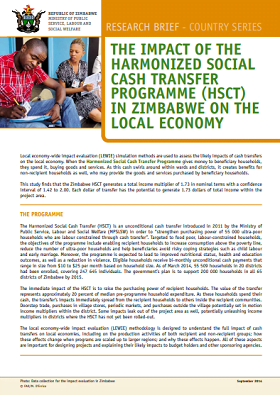The Impact of the Harmonized Social Cash Transfer Programme (HSCT) in Zimbabwe on the Local Economy
Local economy-wide impact evaluation (LEWIE) simulation methods are used to assess the likely impacts of cash transfers on the local economy. When the Harmonized Social Cash Transfer Programme gives money to beneficiary households, they spend it, buying goods and services. As this cash swirls around within wards and districts, it creates benefits for non-recipient households as well, who may provide the goods and services purchased by beneficiary households.
The Harmonized Social Cash Transfer (HSCT) is an unconditional cash transfer introduced in 2011 by the Ministry of Public Service, Labour and Social Welfare (MPSLSW) in order to “strengthen purchasing power of 55 000 ultra-poor households who are labour constrained through cash transfer”. Targeted to food poor, labour-constrained households, the objectives of the programme include enabling recipient households to increase consumption above the poverty line, reduce the number of ultra-poor households and help beneficiaries avoid risky coping strategies such as child labour and early marriage.



